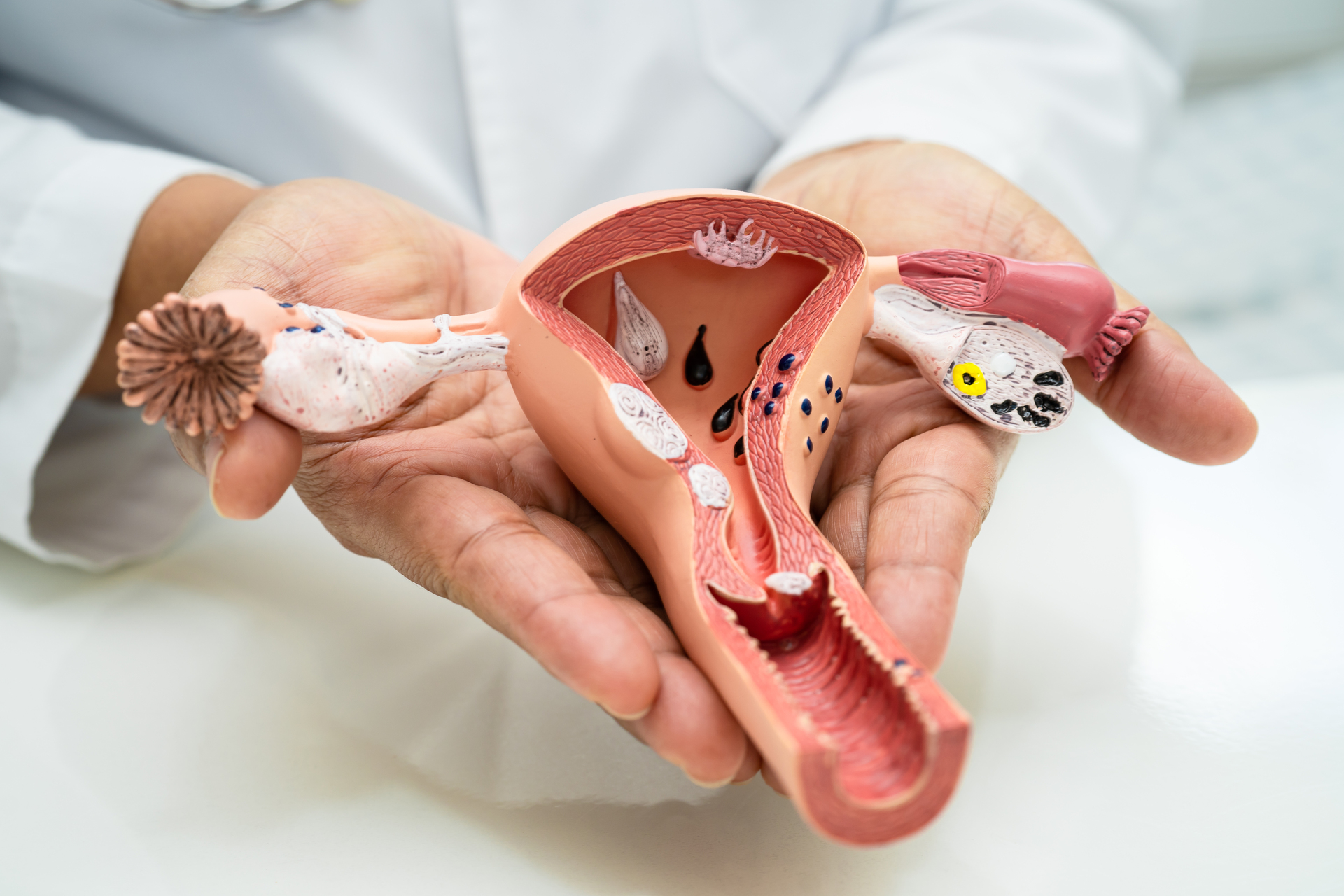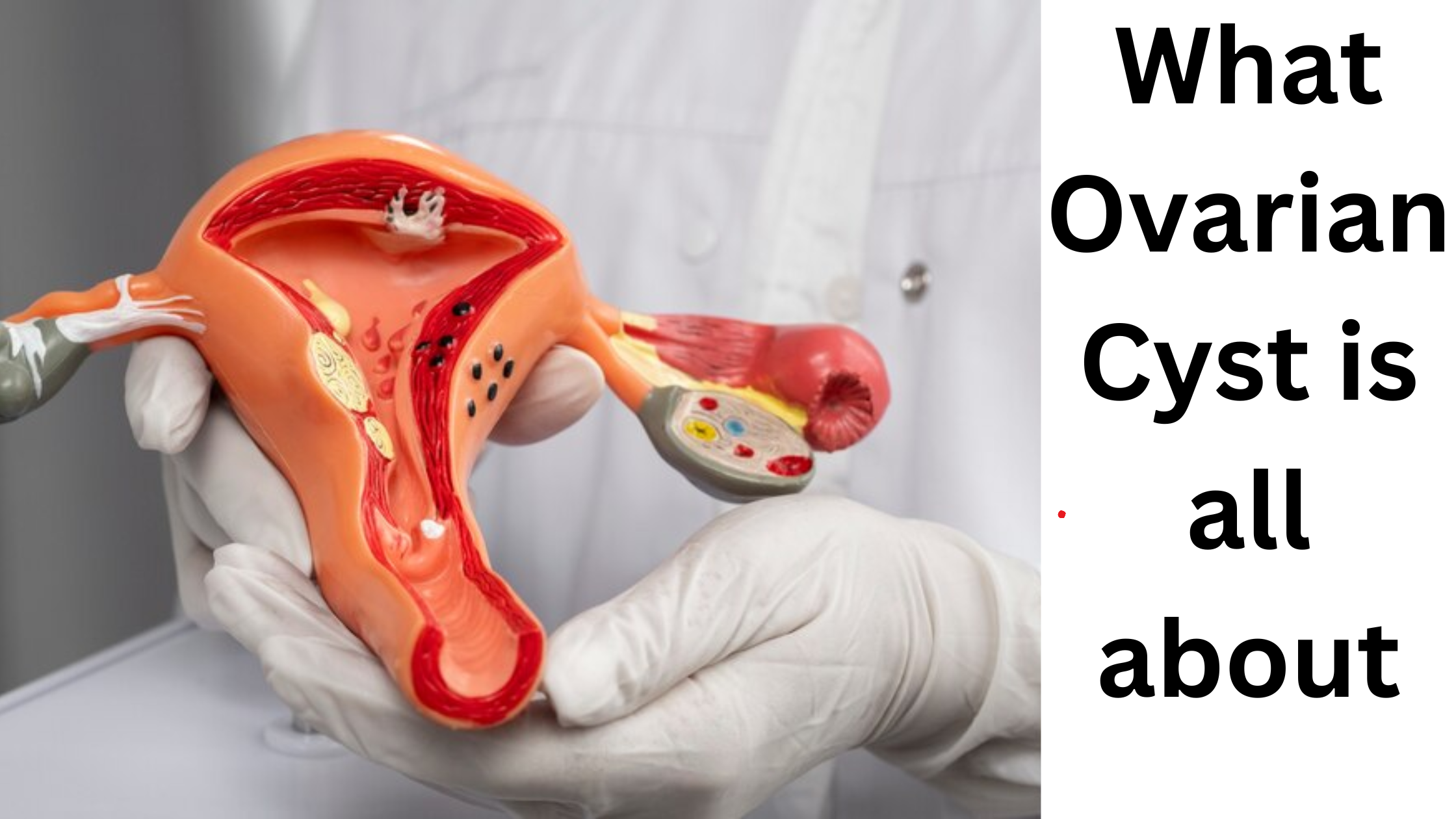What Ovarian Cyst Is All About
Women’s health is a critical component of the public. This article aims to educate healthcare professionals and the public about OVARIAN CYST. An issue regarding women’s health, how to prevent, detect and treatment.
Introduction to Ovarian cyst
Ovarian Cyst is a fluid filled sac that develops on or inside a woman’s ovaries. Cyst can occur at any time, but it happens more in women that are at reproductive age.
It usually develops during ovulation, when the ovaries release an egg.

Types of Ovarian cyst
- Functional ovarian cysts:
What is functional cyst? it is a common type of ovarian cyst. Functional ovaries are fluid filled sacs that form on the ovaries during menstrual cycle.
Types
Follicular Cysts: Form when a follicle in the ovary grows and fills with fluid.
Corpus Luteum Cysts: Form after ovulation, when the empty follicle produces progesterone.
Hemorrhagic Cysts: Form when bleeding occurs within a follicular or Corp
Corpus Luteum Cysts
What is a Corpus Luteum Cyst? A corpus luteum cyst is a type of functional Ovarian cyst that forms after ovulation. It occurs when the empty follicle in the ovary produces progesterone and fills with fluid.
After ovulation, the empty follicle transforms into a corpus luteum, the corpus luteum produces progesterone to prepare the uterus for pregnancy. If pregnancy does not occur, the corpus luteum usually dissolves. In some cases, the corpus luteum fills with fluid and becomes a cyst.
Characteristics of corpus luteum cyst are;
- Filled with clear or blood-tinged fluid.
- Usually resolves on its own within 2-3 menstrual cycles.
- Typically, 2-5 cm in size
Benign neoplastic ovarian cyst
What is benign neoplastic ovarian cyst: it is a non-cancerous growth that forms on or within an ovary. Unlike functional ovarian cysts, which are related to the menstrual cycle and often resolve on their own, benign neoplastic cysts arise from abnormal growth of ovarian tissues. These cysts can grow large and cause symptoms such as pelvic pain, bloating, or changes in menstrual cycles, though many remain asymptomatic.
Common types of benign neoplastic ovarian cysts include
Serous cystadenomas: Fluid-filled cysts that are usually small but can grow quite large.
Mucinous cystadenomas – Largecysts that may require surgical removal if they grow excessively.
Dermoid cysts (mature cystic teratomas)
What is Dermoid cyst: it contains various tissues, such as hair, skin, or teeth, due to their origin from germ cells.
While these cysts are generally not cancerous, they may still require monitoring or surgical removal, especially if they cause symptoms or have the potential for complications, such as torsion (twisting of the ovary).
Cystadenomas cyst
Cystadenoma: Is a type of benign ovarian cyst that develops from cells on the outer surface of the ovary. These cysts can be filled with either a watery fluid or a thick, mucus-like substance. There are two main types of cystadenomas which are;
Serous Cystadenomas:
Serious Cystadenomas can range from small to very large, sometimes growing up to 10 cm or more. They are usually benign but can become large enough to cause discomfort or pain due to pressure on surrounding organs.
Mucinous Cystadenomas:
These cysts can grow even larger than serous cystadenomas, sometimes reaching sizes over 30 cm in diameter.Like serous cystadenomas, they are typically benign but can become very large and cause symptoms like abdominal bloating or discomfort.
If the size of the cyst is large, they can cause abdominal bloating, pain, or pressure on nearby organs such as the bladder or bowel, leading to urinary or bowel issues.
Endometriomas cyst
Often referred to as called chocolate cysts. This is a type of ovarian cyst associated with endometriosis, a condition where the tissue that normally lines the inside of the uterus (the endometrium) grows outside the uterus. When this tissue grows on the ovaries, it can form endometriomas.
Endometriomas develop when endometrial tissue implants on the ovary and forms a cyst. Each month during the menstrual cycle, the endometrial tissue bleeds, but because the blood has no way to exit, it gets trapped, causing the cyst to grow.
Pathological cyst
Pathological cyst Is a type of ovarian cyst that forms due to abnormal cell growth. Unlike functional cysts, which develop during the menstrual cycle and are usually harmless, pathological cysts can either be benign (non-cancerous) or malignant (cancerous). These cysts are less common but may require closer monitoring and treatment.
Types of Pathological Cysts:
Dermoid Cysts (Mature Cystic Teratoma): These cysts can contain various tissues like hair, skin, fat, or even teeth. This is because they arise from cells that can develop into different types of body tissues. Dermoid cysts are usually benign, but they can sometimes grow large or twist (a condition known as ovarian torsion), causing severe pain.Often asymptomatic unless they grow large, causing pain or pressure. Ovarian torsion is a medical emergency.
Cystadenomas: These cysts develop on the outer surface of the ovary and can be filled with either a watery fluid or a thick, mucus-like substance.Cystadenomas are typically benign, they can grow quite large, potentially causing discomfort, bloating, or pressure on surrounding organs. Abdominal pain, bloating, or a sense of heaviness due to the size of the cyst.
Endometriomas: It is usually filled with old blood, often associated with endometriosis. They can cause pain and may affect fertility.
Malignant Cysts (Ovarian Cancer): these cysts may contain solid components or a mix of fluid and solid parts. Complex cysts can be a sign of ovarian cancer, particularly in postmenopausal women. This type of cysts can be cancerous and require urgent medical attention. The likelihood of a cyst being cancerous increases with age, especially after menopause.
Symptoms of Pathological Cysts:
Bloating or abdominal swelling.
Pressure on the bladder or bowels, leading to urinary or digestive symptoms.
Unexplained weight changes Pelvic pain or discomfort.
Symptoms of Ovarian cyst
Symptoms are usually based on their size, types. Many ovarian cysts, especially small ones, are asymptomatic. However, the symptoms of ovarian cyst are;
- Pelvic Pain: Dull or sharp pain on one side of the lower abdomen, where the affected ovary is located. The pain can either be constant or once in a while. Suddensevere pain can occur if a cyst ruptures or causes ovarian torsion (twisting of the ovary).
- Bloating or Swelling: heaviness in the abdomen. Swelling or noticeable enlargement of the abdomen, particularly with large cysts.
- Menstrual Changes: Irregular periods, unusually heavy or light menstrual flow.
- Pain During Intercourse: Discomfort or pain during or after sex, particularly deep penetration.
- Urinary Symptoms: need to urinate or difficulty emptying the bladder, especially if the cyst is pressing on the bladder.
- Hormonal Symptoms
- Weight gain or unexplained bloating.
Sudden abdominal or pelvic pain may indicate a ruptured cyst or ovarian torsion.
Causes of Ovarian cyst
Ovarian Cyst can develop due to various reasons, often related to the normal functioning of the ovaries or underlying medical conditions. Some of the causes of Ovarian cyst are;
- Hormonal Imbalances: Follicular cysts and corpus luteum cysts often form due to hormonal fluctuations during the menstrual cycle. If the normal process of ovulation is disrupted, a cyst may form.
- Endometriosis: In endometriosis, uterine tissue grows outside the uterus and may attach to the ovaries, forming endometriomas. This can result to pain during menstruation and intercourse.
- Polycystic Ovary Syndrome (PCOS) this is a condition where multiple small cysts develop on the ovaries due to hormonal imbalances, often associated with irregular ovulation.
- Pregnancy: During early pregnancy, an ovarian cyst can form to support the pregnancy until the placenta develops. This is often a corpus luteum cyst, which usually resolves on its own.
- Previous Ovarian Cysts: If a woman had cyst in the past, there is a tendency that it may likely develop again.
- Benign or Malignant Tumors: Cystadenomas form on the outer surface of the ovary and are usually benign but can sometimes grow large.
In rare cases, ovarian cysts may be linked to ovarian cancer, especially in the cases of older women.
How to discover ovarian cyst
- Pelvic examination: A healthcare provider checks the ovaries and uterus for abnormalities.
- Abdominal exam: Checks for tenderness, masses, or other abnormalities.
- Ultrasound: Uses sound waves to create images of the ovaries.
- Transvaginal ultrasound (TVUS): Provides detailed images of the ovaries and uterus.
- CT scan: Uses X-rays and computer technology to create cross-sectional images.
- MRI: Uses magnetic fields and radio waves to create detailed images.
- Complete Blood Count (CBC): Checks for infection or inflammation.
- Hormone level tests: Checks for hormonal imbalances.
- Transvaginal ultrasound (TVUS) for women
Ovarian cyst treatment
Ovarian cysts treatment depends on the type, size, reproductive goal of the woman, general health of the woman.
1.Observing Monitoring the cyst with regular ultrasound exams.
2. Hormonal therapy: Birth control pills to regulate hormones and reduce cyst size.
3. Pain relief medicine
4. Laparoscopy: Minimally invasive surgery to remove the cyst.
5. Laparotomy: Open surgery to remove the cyst or affected ovary.
6. Removal of the cyst while preserving the ovary.
7.;Removal of the affected ovary.
8. Acupuncture: To alleviate pain and improve fertility.
9. Herbal remedies: To regulate hormones and reduce symptoms.
10. Dietary changes: To promote hormonal balance
Ovarian cyst and Infertility
Ovarian cysts can potentially affect fertility, but it depends on the type and size of the cyst. Most ovarian cysts are benign and do not cause infertility. Although, certain types, such as endometriomas associated with endometriosis polycystic ovaries (in polycystic ovary syndrome, PCOS), can interfere with ovulation and fertility.
Functional cysts (like follicular or corpus luteum cysts) usually form during the menstrual cycle and typically don’t cause infertility.
Endometriomas are cysts caused by endometriosis, a condition where tissue similar to the uterine lining grows outside the uterus, which can impact fertility.
PCOS is a hormonal disorder characterized by multiple small cysts on the ovaries, and it is one of the most common causes of infertility due to irregular ovulation.
ovarian cysts usually dissolve on its own, but if they’re large, painful, or linked to conditions like endometriosis or PCOS, they may require treatment to improve fertility outcomes.
What is a Ruptured Ovarian Cyst?
A ruptured ovarian cyst is a medical emergency where an ovarian cyst breaks open, releasing fluid or blood into the pelvic cavity. The causes are;
- Large cyst size
- . Hormonal changes
- Ovarian torsion (twisting of the ovary)
- Weakening of the ovarian wall
Symptoms of ruptured ovarian cyst
Ruptured ovarian cyst symptoms can probably vary from mild to severe
1. Pelvic pain or discomfort (sharp or dull)
2. Abdominal tenderness
3. Bloating or swelling
4. Light to moderate bleeding
5. Nausea and vomiting
6. Fever (less than 101.5°F)
7. Dizziness or lightheadedness
8. Sudden, severe pelvic pain
9. Heavy bleeding (soaking more than 2 pads/tampons per hour)
10. Abdominal distension
5. Vomiting blood or coffee ground-like material
6. Fever (over 101.5°F)
7. Severe dizziness or fainting
8. Difficulty breathing
9. Rapid heartbeat
10. Cold, clammy skin
11. Chest pain or pressure
12. confusion or loss of consciousness
13. Infertility
14. Adhesions
15. Infection
16. Ovarian failure
Ovarian cyst sizes and their complications
Small Size (≤2 cm)
• Low risk of rupture or torsion
• Medium (2-5 cm)
• Pelvic pain
• Irregular periods
• Moderate risk of rupture or torsion
Large Size (5-10 cm)
• Abdominal distension
• Bowel/urinary symptoms
• High risk of rupture, torsion
• Severe pelvic pain
Giant Size (≥10 cm)
• Significant abdominal distension
• Respiratory distress
• Cardiovascular complications
• Very high risk of rupture, torsion, hemorrhage
Conclusion
With proper understanding and enlighment ovarian cyst can be effectively managed. Ovarian cyst affects millions of women worldwide, Early detection and diagnosis are needed for effective treatment.

